Latest novel published! Death of a Doppelgänger
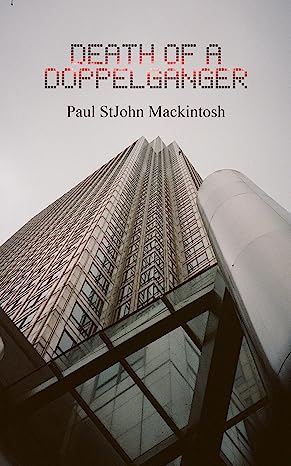
My publisher has just published my latest novel, Death of a Doppelgänger , a psychological thriller and coming-of-age story loosely based on my time at Cambridge in the 1980s. Enjoy!
“It Was Me All Along!”: Cosmic Horror and Mythos Fan Service
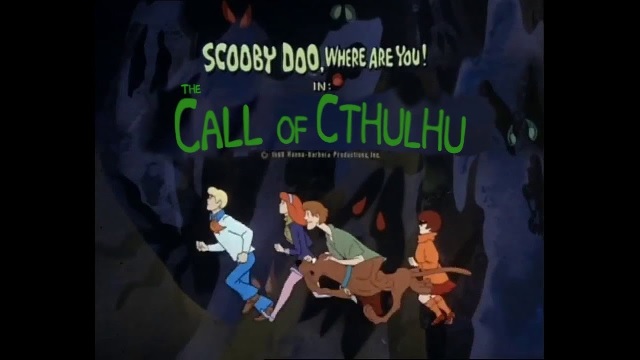
Here’s some thoughts that I had lately about scenario design for cosmic horror roleplaying. Specifically, here’s three outlines of three contrasting horror RPG scenario formats – in principle for Call of Cthulhu 7th Edition, but just as applicable to other Cthulhu Mythos games. The first scenario type kicks off with an initiating event that has very strong Mythos hallmarks. The investigators may or may not know about the Mythos, but they discover more and more about it as they progress. They find traditional myths or historical events in the archives that suggest something of the nature of the Mythos. They encounter relics or mementos of Mythos cults or entities. They find Mythos tomes giving some indication of the type of threat they face and the potential dangers to humanity – as well as possible resources to counter it. They tackle lesser Mythos antagonists that have some fairly credible relationship to the ultimate threat. Finally, they face the ultimate nemesis, which has a suitably unpleasant goal in mind, and defeat it (or not) with the resources they have on hand, or have acquired through the adventure. The complete dimensions of the threats and the challenge have been communicated entirely by the discoveries made by the investigators within the scenario.
In the second scenario type, a bizarre initiating event kicks off an investigation with no apparent logical explanation whatsoever. It may have some strange symbolic resonances but no obvious meaning or point. The investigators start to inquire and are repeatedly baffled. Incomprehensible unnatural events befall them. Strange threats menace them with impossible and inexplicable dangers. These risks and puzzles may have some affinity or common thread with the initiating event or not. Any recorded myths or apparent explanations relating to the events are cryptic and elusive, with no underlying common logic. The investigators may acquire some kind of inkling about how to deal with the apparent gathering menace, perhaps through some imaginative correspondence or other dream-like revelation, but hardly through any process of rational deduction. Finally, they confront the ultimate enigma and vanquish and dispel it (or not), but in any case receive no further clarification about its meaning. There may be very resonant tropes tying all of the elements in the scenario together, but there is no underlying logic that the investigators could ever unravel.
The third scenario type kicks off with an initiating event bearing all the hallmarks of traditional occultism or mythology, and very possibly taking place in a traditional occult or mythological context. All the tropes and set-dressing for the unfolding investigation are redolent of traditional occult lore. The investigators encounter occultists practising traditional occult practices. They experience phenomena and upsets in line with traditional magical and spiritualist beliefs. They uncover traditional occult tomes and grimoires. They encounter lesser threats and dangers completely consistent with traditional occultism and mythology. They may even learn traditional occult spells, and solve puzzles based on traditional magical lore. Finally, they confront the main threat or nemesis, in a denouement totally explicable within the terms of traditional occultism, and defeat it – or fail to defeat it – on those terms, using whatever traditional occult resources and resolutions they may have. Only then does the GM pull back the curtain and finally reveal that the whole setting was Cthulhu Mythos all along, and the key antagonists were actually Mythos entities masquerading as the products of primitive superstition, often avatars of Nyarlathotep. This revelation takes place in the form either of a concluding event that has no obvious organic relationship to the rest of the scenario, or a big data dump, or a combination of both.
It should be obvious what my preferences are out of those three. For anyone puzzling over what might be an example of the second, I’d suggest the classic Delta Green scenario “The Night Floors” – or as someone suggested, much of David Lynch’s output. One of the beauties of the whole Yellow King fork of the Mythos is that there’s never any real explanation of what agenda the King or the court of Carcosa have. They’re not there to wrench the Earth back into another dimension or restore the dominion of the Great Old Ones: they just infect the environment with inexplicable awfulness. Meanwhile, players may or may not find the second structure more intriguing than the first scenario outline, but I don’t think that any players wanting to play a Call of Cthulhu game could object to that first scenario structure. Above all, that delivers Mythos from start to finish, not requiring any player game-world meta-knowledge to up the fear factor or attempt to justify the goings-on, since all the explanation and justification is internal and unfolds from the scenario itself.
That does kind of raise the question of how much Lovecraftian horror is actually cosmic horror in the sense of inexplicable. (Kyle Maxwell recently wrote an interesting post about this.) For a writer with a reputation for hinting at the indescribable with vaguely allusive purple prose, H.P. Lovecraft actually delivered a shedload of detailed explanations in his horror, and I don’t think it suffers as a result at all. In “At the Mountains of Madness,” data delivery almost reaches ludicrous extents, when the explorers gain insights into the history of the Elder Things from their wall art, to a fairly unbelievable level of historical detail. But does the minute anatomical detail of the description of the Elder Things detract from the marvellously suggestive horror of the massacre at Lake’s camp? I don’t think so. Above all, the basic point is that the story gives a full, detailed, rational explanation of itself within itself. There’s some lovely cryptic allusions at the end to something further inexplicable and quite beyond, but those are more like a suggestive coda, keeping open the air of inexplicable wonder. What has really blown the explorers’ and presumably the reader’s minds, meanwhile, is the revelation of historical deep time, and the insignificance of puny humanity in that context. “The Shadow out of Time” hits many of the same notes. And in “The Dunwich Horror,” for instance, we’re left in no doubt of exactly what the Whateleys are up to and what their objective is. There’s an investigation, an uncovering of facts, and a resolution based on those facts – especially since the facts revealed in the Whateley journal and the Necronomicon are exactly what allow the Armitage party to vanquish the last monstrous Whateley.
I’m not trying to detract from Lovecraft’s power to suggest the genuinely inexplicable and incomprehensible, or just to scare people even when he structures a story on a solid investigative footing. There may be plenty of other writers past and present who have gone one step beyond Lovecraft in taking him at his word when he talks about the enigmatic and unfathomable, and actually have actually crafted effective mysteries that have no rational resolution, merely suggestive outcomes often poetically pointing towards the incapacity of the human mind to actually understand and embrace the ultimate nature of reality, or even just what’s going on at the time. I’m very familiar with the Forbidden Planet argument that the invisible monster which people fill in with their imaginations is far more frightening than the visible creation of a special effects budget. Some aficionados may regard this second scenario structure as the more truly cosmic horror, but I don’t think Lovecraft can be faulted for not going all the way to the complete artistic conclusion of his premises.
But the third type of scenario in particular raises a question that I’ve bumped up against while listening to live play after live play of Mythos investigative scenarios with similar endings. Those endings usually consist of the players asking what really happened in the scenario, and the GM giving a long retrospective explanation, frequently with one of the antagonists really being an avatar of Nyarlathotep. Why shouldn’t the investigators actually uncover what’s going on themselves as they actually play the game? Why shouldn’t those bizarre and very juicy Mythos tropes be inserted into the materials that are being uncovered, and point a way towards some kind of potential conclusion or resolution of events that leans on the Mythos? Why should genuinely inexplicable events have to be justified by reference to Lovecraftian tropes, if those aren’t included as an organic part of the scenario itself? What kind of satisfaction are players going to get from a deeper level of meaning if this is only revealed at the very end and does not integrate into the actual play? And as a related point, why should scenarios structured around non-Mythos settings and tropes be hauled back to the Mythos at the very last minute? If that hasn’t organically been part of the scenario from the very start and disclosed in the course of play, what use is it? Doesn’t this bait-and-switch approach leave players feeling rather mystified, disempowered and cheated?
Look at “The Derbyshire Horror” in Masks of Nyarlathotep. Are the players supposed to be led into the scenario believing in werewolves as a potential real thing in the game world? Or are the characters supposed to believe that werewolves could be real – as real as all the other supernatural things they’ve already encountered – while the players go along with the in-joke because they know that Lovecraftian ghouls are “real” but werewolves are just superstition? If the characters don’t have sufficient Cthulhu Mythos skill, why should they know anything about Lovecraftian ghoul lore? For that matter, ghouls are as much a part of traditional Middle Eastern and eventually Western mythology as werewolves (remember that great 1975 Peter Cushing film The Ghoul?), so why should there be a big meta reveal around the fact that Eloise Vane is a Lovecraftian ghoul and not a werewolf? The whole mistaken identity theme could have been worked within traditional folklore without touching on the Mythos at all, even down to fooling around with silver bullets that have no special efficacy.
I don’t get the impression that Chaosium ever required or expected that all products released for Call of Cthulhu should necessarily include Cthulhu Mythos elements. Look at the scenario collection Blood Brothers. Look at “The Haunting,” that classic introductory scenario, which has spooked generations of players without having much overt and obvious connection to the Mythos at all. Advice to Keepers for “The Haunting” specifically states that: “The Liber Ivonis is not central to play, and can be excluded if the Keeper is unready to introduce the Mythos or a Mythos book.” Look at the brilliantly successful Berlin: The Wicked City, whose antagonists and dark forces have only the most peripheral relation to the Mythos. Look at that modern classic The Children of Fear, where Lynne Hardy drops in brief Mythos-related framing material for those who need it at the start of the massive campaign, before unfolding the adventure almost entirely along the lines of Theosophist occultism and traditional tantric beliefs. The world almost comes to an end in that brilliant saga in a thoroughly un-Mythos way. Again, this isn’t to carp at those who do write solid Mythos scenarios – it’s just to point out that no one including Chaosium apparently ever thought that the Mythos was compulsory for the game.
And as for writing the third type of scenario because Mythos deities and entities are more “real” than other mythologies and occult traditions…? Well, it’s an assumption that can be used and mined for its potential value within the game world. But coming to the game setting from the outside as a game setting among other game settings? Accepting that all human mythology, pantheons, supernatural entities etc. are nothing but an appendage to the writings of one weird fiction author in the 1920s and 30s? That’s the kind of fan service that strikes me as doing a big disservice to Lovecraftian fiction and everything else that isn’t cosmic horror. Keziah Mason is a witch who casts spells. Joseph Curwen is a resurrected member of the undead who sucks blood. It’s all equally supernatural fiction and fantasy. There are lots of interesting debates to be had about the position of Lovecraftian and cosmic horror versus the types of supernatural horror that preceded it, but in game terms, they’re all equally fictional alternative game settings, that’s all.
I do think, in short, that there’s a risk of Mythos fan service upsetting otherwise great scenarios, and leading scenario writers astray. I don’t believe that an end-game data dump constitutes a great roleplaying exploration of the Mythos. I do believe that you can have a very frightening and enjoyable scenario that does explain and resolve itself on its own terms as it unfolds, without having to lean on any external layer to provide the actual framework and context. As said, I also believe that it’s possible to have a satisfying gaming experience that is based on the completely inexplicable – but that is a totally different thing from having a meta explanation and refusing to give it until the last second, often after actual gameplay has ceased. There’s a world of difference between a last-minute twist, or the classic horror movie jumpscare where the vanquished horror springs back to life, and a data dump. I suspect that some writers who feel tempted to head in that direction are simply looking to, or feel obliged to, pay fan service, concerned that their scenario will not be accepted in the canon unless it has some kind of Mythos reference within it.
I do think Call of Cthulhu is a great horror game and I don’t see why its scenario writers should feel it needs to be shackled to Strictly Mythos – Chaosium obviously didn’t. And above all I’d just like to see more scenarios written as internally consistent and complete. If you’re going to do a Mythos scenario, then why not do it as one where the Mythos is there full face, up on its hind legs and howling? I have the strong impression that, despite the reams of scenarios published, there are still areas of the Mythos that are way underexploited and underused. How many great campaigns or scenarios have we had about L’mur-Kathulos, Bran, and the Magnum Innominandum? Why should the scenario writer just have the Mythos show up just as an apologetic afterthought? It’s knowledge, not incomprehension, that hauls us off our placid island of ignorance. It’s the terrifying vistas of reality, and our frightful position therein, that drive us mad, and those can be explained and described, as well as just glimpsed or hinted at. That’s what Lovecraft actually did almost every time.
I rather feel that investigative horror gaming works best as horror revealed by gaming the investigation, not horror given a last-minute tail-end boost by pinning on a load of extraneous material. Fine, there may be a good case for the third style of scenario, but at least I think that reason should be a genuine and conscious attempt to create gaming fun through a solid gaming moment. And I appreciate that this whole screed may have come across as very one-true-wayist, but I do think the underlying point is worth drawing attention to.
[Top]A review of Tales from Arkham Sanitarium
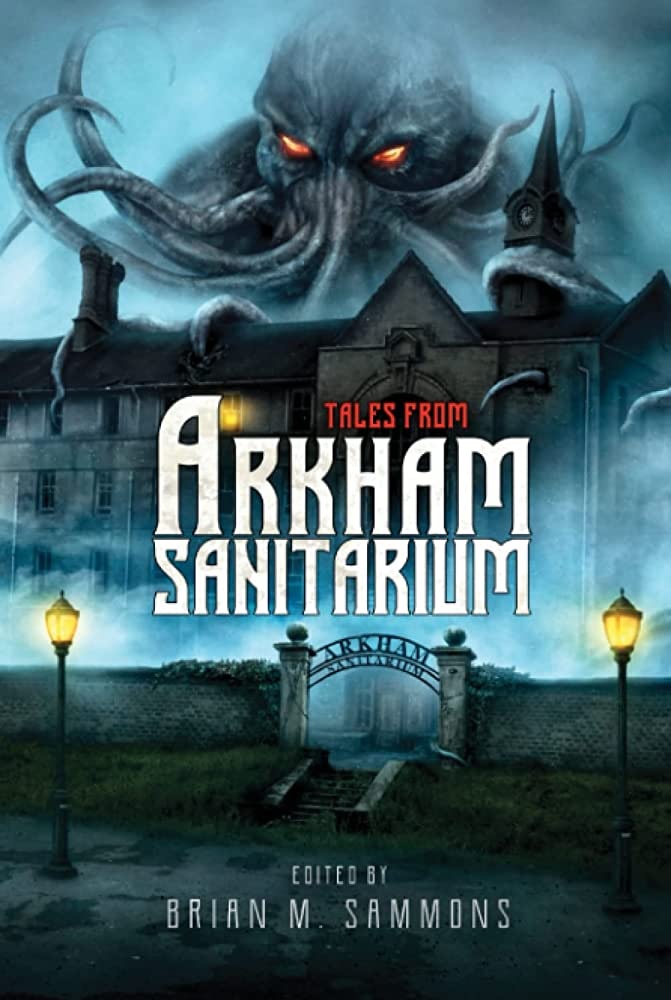
Edited by Brian M. Sammons
208 pages
Dark Regions Press
The premise of this new collection of Lovecraftian horror is straightforward and right on point. As the Dark Regions Press blurb declares, “the insanity that follows in the pursuit of damnable truths, is at the core of many of the stories of the Cthulhu Mythos. Insanity is central to Lovecraftian horror, so there is no wonder that in his witch-cursed and legend-haunted town of Arkham, a cathedral devoted to mending broken minds was raised.” These 15 stories weave variations on that theme, although not all of them are set in the titular sanitarium. It’s obviously a theme that appeals to some highly gifted authors because the contributor list includes some of the leading lights of current weird fiction. Orrin Grey, Nick Mamatas, Cody Goodfellow and Jeffrey Thomas are anything but run-of-the-mill Lovecraft pasticheurs, and the quality of their contributions is correspondingly high.
All credit to the editor, then, for having marshalled them under this banner. Brian M. Sammons is a serial author, editor, anthologist and game designer of dark, horrific, and predominantly Lovecraftian works, and he secured all new original stories for this volume. He told me that “I’ve always liked to do unusual themes for my Lovecraftian anthologies. It’s not enough to just have good cosmic horror stories. I’ve done Lovecraftian anthologies set in the 1950s and 1960s, during wartime, in a cyberpunk future, in a steampunk past, and more… the idea behind Tales From Arkham Sanitarium was a focus on another staple of weird fiction and Lovecraftian horror: madness. I wanted stories that delved into the insanity associated with the Cthulhu Mythos, how it affects survivors and witnesses of things from beyond, how learning the things man wasn’t meant to know can burn, and how cultists and fanatics get that way. So that is what I was aiming for with this book and I think the authors nailed it.”
When the protagonists of these stories do get into Arkham Sanitarium, their ways and reasons for doing so are refreshingly different and interesting. Cosmic Microwave Background Radiation may sound like a really fantastic name for a band, but it’s far less appealing when they’re also a conduit for unnatural contagion, as in the tale by William Meikle. A talking house, or rather, a protagonist who isn’t sure whether they are a person or a house, is definitely a new one on me, but that’s what Christine Morgan manages in “Let me Talk to Sarah”. The stories from W. H. Pugmire and Joseph S. Pulver, Sr., are both among the last that those sadly-missed authors ever wrote. It’s good to be able to report that they are also among the highlights of the volume. Pulver’s story in particular is a virtuoso fantasia with his characteristic typographical and stylistic extravaganzas, almost as delirious as the subject matter, and a real reminder of how irreplaceable his talent was.
One interesting and perhaps telling aspect of the whole exercise is the frequency with which the narratives switch from Arkham Sanitarium to what appears to be almost its sister Arkham institution, Miskatonic University. Many of these sanitarium incumbents are former residents of the university, and in some cases that academic institution looms large, where the theme of madness continues but the sanitarium is hardly mentioned. As it happens, those stories include some of the strongest and weakest work in the book. Edward M. Erdelac’s “The Colors Of A Rainbow To One Born Blind” starts off as a terrific sequence of rolling evocations of favourite Lovecraftian tropes, before ending as a fairly conventional campus shooting bloodbath, all too familiar in fiction and in fact. On the other hand, Cody Goodfellow’s “Forbidden Fruit” is a disorienting exercise in seriously bad archaeology that has sunk its claws into my imagination like it wants to live there. It’s that characteristic Lovecraftian message: Knowledge leads to madness. Knowledge is madness. Madness and knowledge are two sides of the same coin. To paraphrase Lovecraft, the piecing together of dissociated knowledge has opened up such terrifying vistas of reality, and of our frightful position therein, that we have gone mad from the revelation – and the gates and cells of Arkham Sanitarium yawn wide to receive the enlightened recipients of such knowledge. Recommended.
[Top]A review of Regency Cthulhu: Dark Designs in Jane Austen’s England
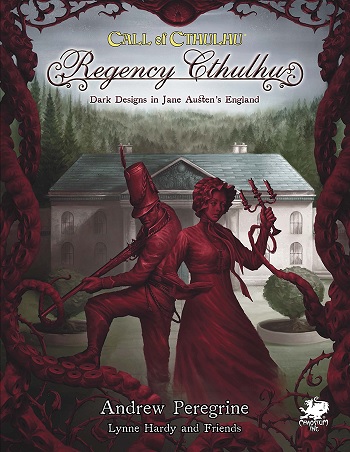
by Andrew Peregrine, Lynne Hardy and Friends
226 pages
Published by Chaosium, 2022
Your mileage may vary, but I’ve found that the more detail, meat and juice there is in a historical sourcebook for an RPG, the more I get out of it, and the more stimulating and just plain useful it is. I mean, there’s usually so much unexpected, fascinating, and crazy stuff going on in any one timeframe that you only need shake the box a little to have fabulous scenario seeds pouring out. That’s got to be worth the cost of admission, right?
So I was hoping for a lot from Regency Cthulhu. Did I get it? Well, in its 226 pages, the Introduction is basically all the generally explanatory material on the Regency era – and it’s only 16 pages long. Actually, half of that is a Regency timeline – so in fact, for this introduction to an unfamiliar, incredibly diverse and dramatic historical setting, we’re looking at a grand total of eight pages, with a lot of half-page illustrations to cut down that text even more. That’s close to the length of the setting introductions for each individual chapter of Masks of Nyarlathotep.
As the Introduction states, the book really focuses on the Regency as strictly drawn – the “reign” of the Prince Regent, between 1811 and 1820 – pretty much Jane Austen’s entire mature publishing career. Yet even within that period, there is so much fascinating and supremely gameable material that it leaves out. For instance, Byron, Percy Shelley, Mary Shelley, and Polidori had their great horror story contest on the banks of Lake Geneva in 1816, which produced Frankenstein in 1818. There’s Beau Brummell and the political shenanigans of the Regency itself. There’s the first steam engines. There’s the Peterloo Massacre. And then there’s the culmination of the Napoleonic Wars. Yes, those Napoleonic Wars – the Retreat from Moscow, the Hundred Days, Waterloo, and all that.
There are great cultural currents in the period that flow right into horror and horror gaming. I’ve already touched on a couple of really massive peaks that helped shape the entire horror genre. They’re often classed as the second generation of Gothic literature – and Jane Austen herself cut her teeth (pretty literally) on satirizing the first generation. Austen’s decorous, refined culture existed in dynamic counterpoise with the dramatic, hysteric excesses of Romanticism – John Martin’s apocalyptic canvases, William Beckford’s erection of his bizarre follies at Fonthill Abbey and Landsdown Tower, Walter Scott’s rediscovery of the Scottish Crown Jewels, John Polidori’s publication of his vampire tale The Vampyre, and so on, and on, and on. All of which features hardly at all in this book.
In Regency Cthulhu, pages 8 to 42 are devoted to the introduction, a general outline, and the period and customization details needed to create a Regency investigator. Some six pages are devoted to equipment and price tables, and other period details. The production values are high, yes – in the same current generic Chaosium house style, which is pretty solidly good (although perhaps a touch lacking in the kind of neo-classical feel that could have fleshed out the sense – and sensibility – of the period). And the rest is almost entirely devoted to three interconnected scenarios and their supporting handouts and pregens. I understand from podcasts that the book grew out of Andrew Peregrine’s own independently developed Regency scenarios, rather than the scenarios being commissioned to match the system. And yes, they’re three very good and playable scenarios, rich with the flavour of the period, and providing plenty of setting and character detail that can be worked into a campaign. But that is exactly how much this book gives you to create your own Regency setting and Regency investigators – the bare bones. The new Reputation system is a terrific addition to the Call of Cthulhu repertoire, and perfectly tailored to Regency society, while potentially being adaptable for Gaslight and other eras too, but it’s a new mechanic, rather than a presentation of source material for a sourcebook.
I sadly feel the lack in Regency Cthulhu of the phenomenal density of historical and cultural detail that went into Lynne Hardy’s brilliant The Children of Fear. It feels like an RPG version of Bridgerton – a costume pastiche whose knowledge of the era goes no deeper than its frocks. And I know that’s not representative of the authors’ knowledge or love of the period, but it’s all that gets through here. It’s kind of indicative in my view that the handouts include a one-page summary of the Regency era – presumably for players who can’t even be bothered to go through the fairly basic introduction to the period in the book. There is so, so much great gaming material and potential from the period that’s hardly even referenced in a one-liner. Fine, you can’t cover everything – but Chaosium has covered loads more, in supplement after supplement, in its recent production lineup. The Children of Fear, in contrast, is about twice as long, at 416 pages, and infinitely deeper in detail, even though its setting is far more alien. Or look at David Larkins’s Berlin: The Wicked City, with its dazzling and decadent recreation of the spirit and fleshy details of the Weimar period. And couldn’t there have been more genuinely period illustrations in the book, instead of just more Chaosium house style art, since it covers an epoch of fabulous imagery, from Gillray’s satires to Blake’s phantasmagoria? How about a map of Bath, or Regency London? Or some period pamphlets? I mean, call me an intellectual snob if you like, but I haven’t found any reason to complain about lack of detail in any of Chaosium’s recent sourcebooks and scenarios, and I’ve read and/or reviewed just about all of them. And those incorporate a great deal of input from some of the same writers. So if those standards were applied there, couldn’t they have been applied here? I know that the authors are huge fans of the period, and it’s a colossal shame that their enthusiasm couldn’t have been reflected in more material that is – well, source material. And yes, it’s true that some key modern properties about the period, such as Bernard Cornwell’s Richard Sharpe series, or Patrick O’Brian’s Aubrey–Maturin cycle, are still in copyright, but Frederick Marryat’s Mr Midshipman Easy isn’t. Nor is Nightmare Abbey. Nor is Vanity Fair. Or Charlotte Bronte’s Shirley. Or Billy Budd. Or Shelley’s Zastrozzi.
I understand that other follow-up publications to Regency Cthulhu may be in the offing, and I’d really love to see a Napoleonic or Romantic CoC sourcebook from Chaosium to flesh out what this one has missed – because IMHO it does stand in need of them. (And no, I am not pitching for work myself here – just commenting.) Rather than a sourcebook, it reads like three extended scenarios with a fairly abbreviated historical background. Even the appendix updating the scenario setting of Tarryford to 1913 is longer than the consecutive space given to the source material; just turning those 9-10 pages over to real Regency content could have made this a hugely more fruitful and faithful resource for Keepers.
This is the first Chaosium product in ages that I wouldn’t rate as an instant classic – which is kind of praising with faint damnation, maybe, but there you go. I’m reminded painfully of the title of another great English novel that followed a bit later – Great Expectations. That’s what mine were. I realize Chaosium can’t roll a critical hit every time, but it’s a shame that this one had to be the one they missed on. Ah well, back to Reign of Terror.
[Top]Black Ballads, my latest, in Kindle Best Sellers!

Somehow, Black Ballads, my latest title, reached #31 in Amazon.com’s Kindle Best Sellers in British Poetry on 6 October! It’s a niche category for sure, but it’s still a great feeling to see yourself up there alongside Milton and Shakespeare!
[Top]A review of Vaesen: Mythic Britain & Ireland
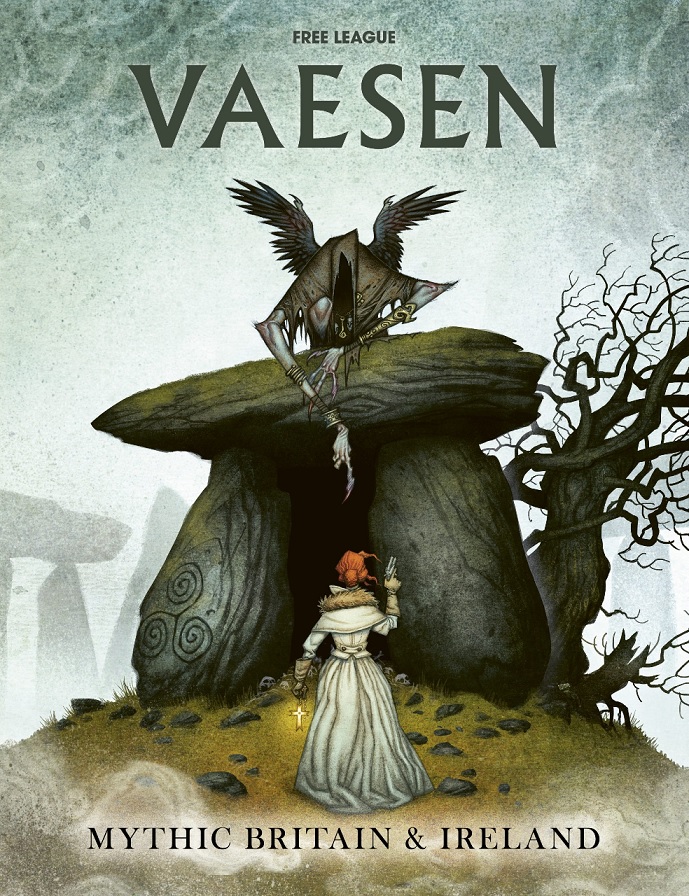
164 pages
Published by Free League (Fria Ligan), 2022
Vaesen: Mythic Britain & Ireland arrives as a welcome, but hardly unexpected, pleasure. The Kickstarter for this supplement blew through its target in just six minutes, and finished over 60 times overfunded, with stretch goal after stretch goal unlocked. Was it worth the wait? Well, Free League is practically a guarantee of quality, and Vaesen is one of the best pedigrees a gamer could wish for. And Vaesen: Mythic Britain & Ireland doesn’t disappoint.
At 164 pages, it’s not the biggest roleplaying supplement you’ll ever see, but it has been produced to the same immaculate standard as the original Vaesen, with similarly superb artwork. Indeed, Johan Egerkrans, whose work inspired the original RPG, is lead artist for this production too. Lead writer is veteran gaming author Graeme Davis, who has been producing one-off creature sheets for Vaesen on DriveThruRPG for ages now, many of them very British. So you’re pretty much guaranteed something of Free League’s usual high quality out of the gate.
This is definitely an expansion supplement: you will need the original Vaesen rules to play the game. (What, you don’t have them already? How could you deprive yourself this way?) What you do get is a framing narrative to situate Vaesen: Mythic Britain & Ireland in the same old-vs-new 19th-century confrontation as in Vaesen’s Scandinavia, a guide to the British Isles of the time (mundane and occult), a society (the Apollonian Society, no less) to provide the same campaign structure as its sister organization in Uppsala, new character archetypes (the Athlete, Entertainer, and Socialite), thirteen new and very folkloric creatures to challenge investigators as well as guidelines on how to adapt existing vaesen to the British setting, and three very extensive scenarios ranging from Wales to Hampstead. As any Vaesen player knows, that should give you 16 new adventures out of the box, with each creature having its usual peculiarities and unique responses to conflict. Vaesen: Mythic Britain & Ireland players will likely have settled down into a long-running campaign before the GameMaster even needs to think of stepping outside the basic book to look up further sources and inspirations in the Bibliography. As with much Vaesen material, my only caveat is that I wish there could have been even more of it, but that’s a good problem for any game to have, and as said, there’s more than enough here to keep a gaming group busy for many sessions on end – well over a year’s worth, if you reckon on one session per week and an average of three sessions per creature or adventure.
Vaesen: Mythic Britain & Ireland is an expansion that the game has been crying out for ever since the original game debuted, taking the Vaesen experience into new and very fertile territory. It maintains all the charm of the original, while tapping into one of the richest and most thoroughly documented pools of folklore on the planet. And in the unlikely event that you ever tire of playing, you can always just sit back and luxuriate in the gorgeous pictures. Highly recommended.
[Top]A review of Vaesen: Nordic Horror Roleplaying, and Vaesen: A Wicked Secret and Other Mysteries
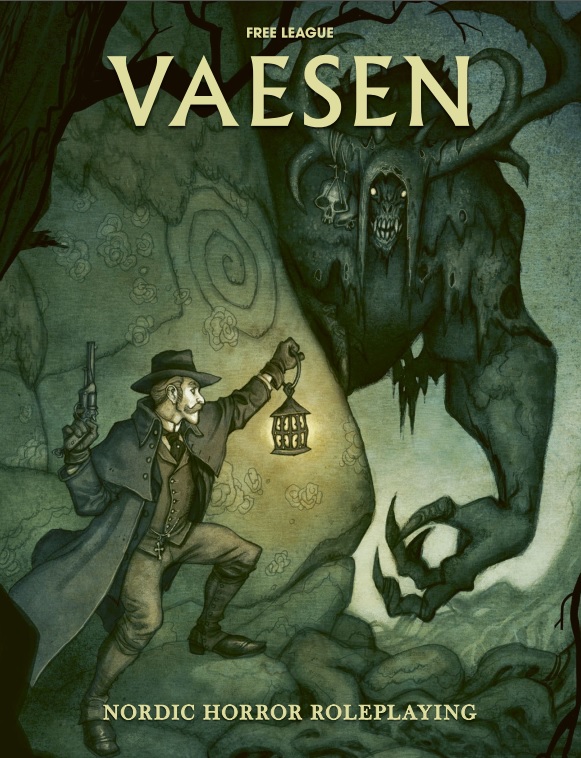
Illustration and original concept by Johan Egerkrans, writing by Nils Hintze and others
240 pages / 112 pages
Published by Free League (Fria Ligan), 2020
I won’t add to the many laudatory reviews of Vaesen from Sweden’s Free League (Fria Ligan) by just doing a straight runthrough of its qualities as an RPG. Rather, I want to use the game to pick a personal bone with the RPG horror landscape as it stands. It’s the bone that pulled me into RPG writing in the first place. So if the following review seems egocentric, I’m sorry; but Vaesen really doesn’t need me to speak for it – it can more than make a case for itself.
For a start, the game – inspired by and substantially created by the Swedish fantasy illustrator and author Johan Egerkrans – could well have been subtitled “Nordic Folk Horror Roleplaying,” and that’s all to its credit. For the purposes of this review, I could dub it “Trembling Without Tentacles.” When I wrote my first horror RPG, I did it substantially because I was fed up with the Lovecrafting of horror gaming, where every pantheon and every legendary being was warped into a manifestation of the Great Old Ones. Call of Cthulhu saturates horror gaming, or at least did so before the recent wave of indie RPGs, and the advent of Powered by the Apocalypse and the alternative rule systems typified by both the OSR movement and the minimalist “tiny” rulesets. For too long, Call of Cthulhu was the monocrop that cut out all other species of horror game from the light. I’ve had more than one horror RPG podcast recently remind me that Call of Cthulhu got to the table first, right at the start of the hobby, and has buttressed its position with reams of high-quality scenarios and campaigns, so that GMs and players need little added effort to immerse themselves in it and it alone for years on end.
That’s all well and good, except that horror gaming has so much more to offer than just tentacles and existential terror. Look, for instance, at the success of Monster of the Week, or Monsterhearts, or Alien, as very different takes on the horror genre that bring fresh and very enjoyable experiences to the gaming table. Look at the immense troves of fascinating material in the world’s folk cultures and traditions – all of which get distorted and bowdlerized as soon as they’re tapped for Call of Cthulhu gaming, into manifestations of Nyarlathotep and miscategorized Deep Ones. Look at ghost stories and psychic investigations, which get very thin coverage from Lovecraft (perhaps because of his nihilistic materialism), but which nonetheless are the very stuff of horror, and rich in potential for RPGs. When I wrote Casting the Runes, I did it exactly because Lovecraft’s legacy to gaming was cutting out or trivializing the great tradition of ghost stories that Lovecraft himself revered in his own critical writing. Look at all the different kinds of horror story that are totally unlike Lovecraft’s own vision of cosmic nihilism. It’s no wonder that Call of Cthulhu proved to be a superb base for some great board games when the underlying narrative thrust of so many Mythos stories is so repetitive and predictable.
So it’s great to embrace a game whose strengths are all about traditions utterly removed from Lovecraftian horror. Instead, Vaesen dives headlong into Scandinavia’s rich heritage of legendary beings, and comes up smelling all the fresher for it. The titular vaesen (supernatural beings) are described in loving detail, with 21 fully covered and more than enough guidance to create more based on the included templates. Each has its own unique Powers, and Conditions that kick in as the creature is stressed during conflict – for instance, the Ash Tree Wife dissolves into ash leaves when it’s defeated, while a Brook Horse can lure or grab a victim in its teeth and drag them off for a mad brook ride. The mid-Victorian, vaguely steampunk Scandinavian setting is not only flavourful, it also supports the trope of modernity versus tradition which is one of the game’s major themes. A game which unapologetically presents folklore and established traditions, instead of jamming everything into the Lovecraftian cookie-cutter, not only has the attraction of new and interesting creatures to face, but also allows for a slew of different flavours of stories and themes. Instead of devolving to the persistent Cthulhu Mythos tropes of cosmic horror and an indifferent, malignant underlying reality, players of Vaesen can tackle threats no less menacing but with a whole different range of emotional registers. You don’t often get pathos from the loss or the defeat of the inexplicable in Call of Cthulhu and its ilk, but such topics spring up naturally in Vaesen. Both Christianity and Norse paganism can be brought to the gaming table in full, for all the dramatic and imaginative potential they can supply. Human issues and sentiments, such as longing or betrayal or revenge, can be framed in the context of the supernatural to produce some great gaming drama, without the Cthulhoid trope of humanity as ants whose concerns are trivial and whose existence is worthless.
As for the propriety of creating an RPG inspired by an illustrated book – well, plenty of RPGs have been inspired by comic book properties and delivered a perfectly good game. Gamers steeped in CoC shouldn’t need reminding that Clark Ashton Smith was a noted artist as well as a horror writer, and he bulks almost as big in the Cthulhu Mythos as Lovecraft himself. Johan Egerkrans, meanwhile, taps into a Scandinavian vein of folkloric and folk horror illustration almost instantly recognizable through the work of John Bauer and Theodor Kittelsen. One website devoted to troll painters lists 72 of them – more than enough to inspire many a new Vaesen scenario. Few of them outshine the artwork in Vaesen itself – the book is visually stunning to a remarkable degree, even by today’s very high RPG production standards, or Free League’s superlative track record. What’s more, the plates and illustrations are inspirational enough in themselves to fuel players’ imaginations (and nightmares).
Not that Vaesen is a totally different gaming experience. The Society whose investigations supply the successive scenarios of Vaesen recalls the Friends of Jackson Elias, Delta Green, or many another league of paranormal investigators. Castle Gyllencreutz, their base of operations with its long and varied menu of Upgrades, is a ringer for numerous headquarters of similar societies. The emphasis on Traumas and Dark Secrets in character creation will be familiar to gamers who have played Kult: Divinity Lost or Fate games. Many of the ingredients are very familiar – but they’re mixed together into a delicious and stimulating whole that doesn’t come across as stale or derivative.
For its mechanical base, Vaesen uses a fork of the Year Zero engine developed by Free League for the game of the same name. I’ve never been a huge fan of dice pool systems; but this one I know has developed a faithful following through the Alien RPG and Free League’s other properties such as the Tales from the Loop RPG, and is well tuned to Vaesen itself, with only moderate pools. There’s also the kind of fun flip you see in the PbtA games, where dice results produce all kinds of interesting and unique consequences, above all for injuries and mental damage, instead of just grinding down the hit points. Free League has been able to develop and refine the system through a succession of games, and the system in Vaesen is therefore well geared to the setting. The core book includes a comprehensive guide to structuring mysteries, with quite a few random tables for sandbox inspiration, and a single adventure, “The Dance of Dreams.”
Vaesen probably needs scenario supplements like A Wicked Secret and Other Mysteries more than many other horror RPGs, though. It’s not that the game lacks the stuff to feed a GM’s imagination. It’s that so much of the rich flavour of the setting depends on a lot of creative preparation, and the relatively simple mechanics limit the generative potential of the system in abstract. Vaesen needs a really strong, solid, well-developed, richly detailed storyline to show its best. That may be a lot of work for many GMs. Fortunately, that’s just what it gets, times four, with A Wicked Secret and Other Mysteries. The game rings the changes on locations, from the Bohuslän islands in far western Sweden to the castle town of Arensburg (modern Kuressaare) in western Estonia. As mentioned, the very detailed scenarios add further depth to the setting and its lore, and deepen the overall atmosphere. And, of course, there are fresh vaesen, in the shape of the gloson (a monstrous spectral sow) and the kraken, as well as sorcerous human adversaries.
Will I become a big Vaesen fan? I’m unlikely to play it as it stands, but I’m definitely going to plunder it for inspiration and resources for other games, and I’m delighted that it exists. Vaesen’s vaguely steampunk 19th-century frame setting could easily be ported to other game systems, and still retain much of the game’s charm. The underlying dynamic of civilization versus Nature, Reason versus inexplicable Mystery, is perennially rich in scenario potential. On the other hand, players who aren’t RPG system nerds, and just want a solid and satisfying experience out of the box, won’t be disappointed, and likely won’t feel any need to look further than the game’s basics for satisfying play. Vaesen renders its setting and its subject matter supremely well. That sounds like a pretty good definition of a good game – as opposed to a good implementation of a gaming system. I don’t know if we really are living through a new golden age of delightfully different horror games, but if we are, Vaesen is prime evidence for the thesis.
[Top]A review of Delta Green: Impossible Landscapes
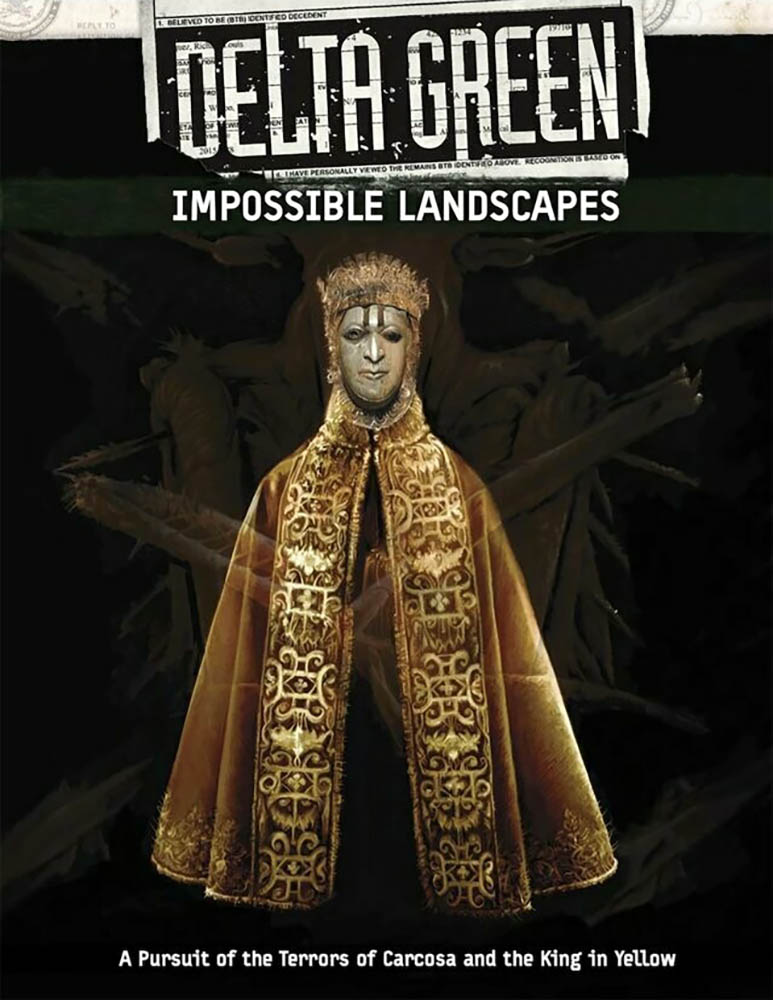
Written and illustrated by Dennis Detwiller
368 pages
Published by Arc Dream, 2021
Impossible Landscapes started life as a stretch goal in Arc Dream’s original Kickstarter campaign to resurrect Delta Green as a roleplaying system and standalone game franchise in its own right. To say that it’s been eagerly anticipated is a massive understatement. Arc Dream was already responsible for Kenneth Hite’s stunning, and often revelatory, The King in Yellow – Annotated Edition (2019), and Dennis Detwiller has been lauded in RPG circles as the arch-exponent of Robert W. Chambers’ King in Yellow Mythos. As Detwiller said way back in 2015, “I created this campaign to ask – what would a full length campaign against Carcosa and the forces of madness and dissolution look like? What if, even after you escaped the Night Floors, they stayed with you? Could you escape? Can you win against madness incarnate?” And now Impossible Landscapes has finally arrived – already available in PDF, and in print from May 2021.
Just a word on Dennis Detwiller, for those who don’t already know his formidable reputation. This is the original writer, over 20 years ago, of “The Night Floors,” the seed adventure for this escapade, rated as one of the most unnerving, surreal cosmic horror RPG investigations ever penned. This is the legendary scenario designer who doesn’t believe that an adventure is complete without player-character casualties, who has put together some of the darkest, most unforgiving developments of the Cthulhu Mythos. His credo is: “Death is not only a part of Delta Green, it is its foundation,” and that “once a threat’s actions, stats and behaviors can be guessed, it is no longer frightening.” What else could you expect but an utterly brutal and unsparing roller-coaster ride?
As a physical product alone, Impossible Landscapes commands attention. It takes the cut-up aesthetic already developed in the Delta Green core books, and cranks it up to 11. The result is like the mutant offspring of a drug-fueled coupling between an Agency case file and an Edwardian occultist’s scrapbook. A few of the illustrations have appeared in previous Arc Dream products, but the plethora of new material and the unifying vision render that a quibble. I wouldn’t be surprised to see Impossible Landscapes in the Finalists listings for the Best Layout and Design and Best Art, Interior categories for the next ENnie Awards.
The content matches up to the design and presentation: no surprise, seeing as Detwiller is in charge of both. The book is divided into four major episodes or sub-campaigns: “The Night Floors,” “A Volume of Secret Faces,” “Like a Map Made of Skin,” and “The End of the World of the End.” Each of these has enough sub-modules and byways to ensure that players don’t feel too tramlined, and that no two playthroughs will likely ever follow the same trajectory. “The Night Floors” is a do-over of the original scenario, but enormously enriched in content and context. Any player who has gone through the original version needn’t fear repetition and ennui; there’s enough going on to make this a whole new experience. There are also three shorter interstitial episodes that can be used to transition major sections, but that also form further sub-adventures in themselves: “The Bookshop,” “The Missing Room, and “Hotel Broadalbin.” There are extensive handouts for the player-facing materials, supplied alongside the basic PDF.
How is it as a game, then? Well, any old-time Call of Cthulhu fan who wants tentacles and noodly appendages is going to be disappointed. This is not a monster mash, or even a body horror adventure: the horror is existential, psychological and surreal. In keeping with the book’s persistent themes, many of the menaces are automata or puppets; creatures long associated with the King in Yellow Mythos, like Byakhee, hardly put in an appearance. However, that departure from 40 years of Lovecraftian RPG tradition is exactly where Impossible Landscapes succeeds best. Not every attempt to put the King In Yellow Mythos into RPG scenario or game form has succeeded in making it genuinely unsettling: some merely succeed in making it seem quaint, or even slightly kitsch. No such worries on Detwiller’s watch. His Carcosan contamination genuinely is a creeping yellow canker on reality, whose manifestations are sometimes jaw-dropping in their insidious subversion of normality and sanity. As if Delta Green’s Sanity countdown and Bond-burning weren’t already corrosive enough, Detwiller has also introduced a new incremental mechanic, Corruption, which measures how deeply under the spell of Carcosa an Agent has fallen. That’s the kind of mechanic that definitely allows for alternative paths and approaches in the campaign: needless to say, the consequences of high Corruption are sometimes empowering, but ultimately Not Good.
Given all that’s gone before, no one should be surprised to hear that this campaign is a meat grinder. Mundane death is the least of the threats facing Agents, who are more than likely going to be either driven mad or sucked into the nightmare of Carcosa. As Detwiller points out in his introduction, “each of these four operations includes suggestions for bringing the Agents’ allies aboard as replacements for lost Agents.” It’s also one of the bleakest ever portrayals of Delta Green as an organization. Always a denizen of morally grey areas, Delta Green in all its multiple incarnations is sketched here from charcoal to deepest black: players may end up wondering if it is anything more than a manifestation of the madness it pretends to fight.
There are some issues. I’m not hugely fond of the kind of layout that refers you to stats for a creature or NPC at the end of the section, or the book, instead of close to where it appears. There are some foibles in the typesetting that may be surreal and distorting artistic invocations of the disorienting Mythos – or just layout errors. And the constant internal cross-referencing and paranoid exercises in apophenia, where names and places and numbers and generations inexplicably interrelate and reflect each other across time and space, can seem a little overdone at times, no matter how faithful a portrayal of a schizophrenic worldview they are.
There’s also, ultimately, a fundamental point about the thesis and structure of Impossible Landscapes, which may turn off some players: This is a game you can experience, but cannot win. You can survive it, and if you’re exceptionally lucky, and skillful, you might get to return to your old life more or less intact. But there’s no keeping the ultimate terror at bay, no closing Pandora’s Box. There’s a persuasive case that Delta Green, and Lovecraftian horror in general, are all about the limits of human agency when faced with the utterly inhuman – in Delta Green’s case, especially the kind of human agency that runs around shooting things and blowing things up. The protagonists in Impossible Landscapes certainly get to do plenty of that – the episodes are not structured as passive exercises in absorbing Handler exposition. There’s always plenty of choices to be made, and dice to be rolled. But none of it ultimately matters. The King in Yellow will always be on his way, today or (thanks to your actions) tomorrow, but never delayed for too long. Carcosa is always waiting to break through into mundane reality, and consume it like the sham, hollow pasteboard Potemkin fraud it has proven to be. Isn’t that the whole point, and the source of the terror, though? And even if you can’t hold back forces as inexorable as gravity or the course of the stars, the experience alone is worth the price of admission.
Impossible Landscapes takes one unsparing vision of cosmic horror about as far as it can go in RPG terms. Even the parent game, with all its frightful scenarios, doesn’t have this level of terrifying excess. Even a setting like KULT: Divinity Lost comes across in comparison as both preachy and a sop to human vanities. Perhaps some of the most appalling monstrosities in Fear Itself, or the utterly pessimistic horror of Thomas Ligotti, are the closest parallels. Impossible Landscapes over-delivers on its promise and premise by the poisonous yellow bucketful. An immediate, indispensable, classic.
[Top]A review of The Red Book of Magic
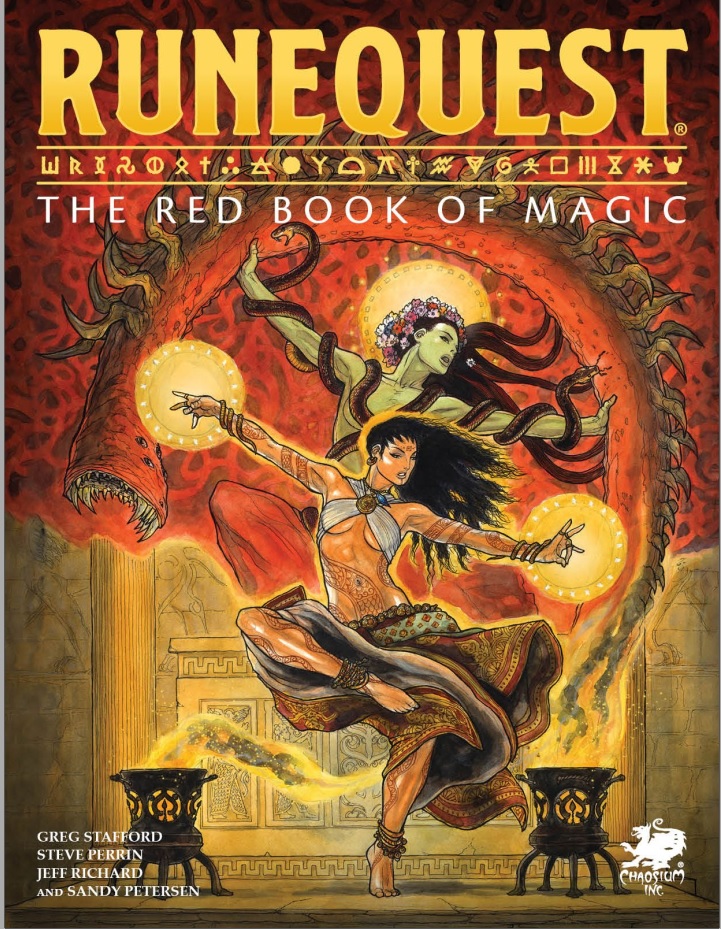
Written by Jeff Richard, Greg Stafford, Steve Perrin, and Sandy Petersen
128 pages
Published by Chaosium, 2020
According to Chaosium, The Red Book of Magic originated as a spell catalog for the yet-to-be-released title Cults of Glorantha, which quickly grew into a whole undertaking of its own. You can see why. As the Introduction says, “this book contains every Rune and spirit magic spell known at the time of publication, including many otherwise unpublished spells.” For some RuneQuest fans who have come across the complaints that many seasoned and new RuneQuest players have made about the Sorcery magic system in new-generation RuneQuest Glorantha that coverage will come as a relief. The book concentrates on the classic RuneQuest magic known since the beginnings of the system in 1978: Rune Magic, and Spirit (a.k.a. Battle) Magic. Sadly departed luminaries like Greg Stafford who authored many of the spells are therefore still referenced in the credits.
So yes, this is a lavish compendium of new and familiar spells for RuneQuest. There’s over 500 in all, along with new details on Rune metals, healing plants, illusions, and other quirks and intricacies of magical lore in Glorantha. If you already have every previous edition of RuneQuest, and every magic-related supplement ever published, do you need this book? Perhaps not, but if you didn’t pick it up out of purely instinct, you’d still be doing yourself a great disservice. Let’s leave aside the fact that this really is probably the most complete single reference book to classic RuneQuest magic around, and therefore valuable to all but the total completionist fanatic. The artwork is absolutely stunning, and easily up to the standard of the current edition of RuneQuest Glorantha. Did the artists and designers try to surpass that benchmark? I wouldn’t be surprised, because the book is a visual delight and worth owning for the pictures alone. Glorantha, and its weird and wonderful denizens, have rarely ever looked more fully realized, and more dazzling.
Then there’s the new content over and above the spell listings themselves. The sections on how the respective types of magic appear, sound, and feel are certainly going to add greatly to players’ experience when roleplaying their spell casts. Special breakouts on particular issues, such as the very powerful and common Heal Wound spell, “the most powerful healing magic available to most adventurers,” may help settle some gaming debates, and certainly help nail down key points in the entire magic system. Solid guidance on devising new spells will help grow the corpus even further.
As for the spells themselves, there’s everything from familiar standbys to the gloriously obscure and arcane. For instance, Bless Woad “can only be cast by a Wind Lord of Orlanth during the High Holy Day of Orlanth upon a properly prepared pot of woad (a blue dye derived from the woad plant), and thus can only be cast once a year.” As a practical spell, it doesn’t go very far: as a flavourful detail of setting and culture, it’s delightful.
Of course there are other RuneQuest spell books and magic-focused tomes out there, both Chaosium originals and independent productions. Simon Phipps’s Book of Doom in the Jonstown Compendium offers a claimed over 600 new spells. Nonetheless, if there’s one single must-have magic book for the RuneQuest universe, IMHO, it’s now surely this one. RuneQuest’s rebirth in the hands of Chaosium is throwing up some delightful books, and this is definitely one of them. It makes me eager to see what comes next.
[Top]A review of The Children of Fear
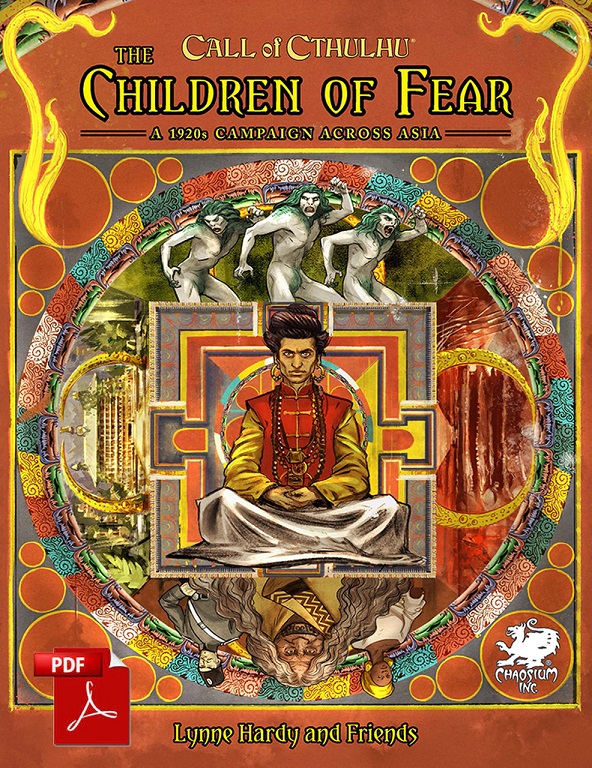
Written by Lynne Hardy and Friends
418 pages
Published by Chaosium, 2020
I have now gone through The Children of Fear, Chaosium’s new epic 1920s campaign for 7th Edition Call of Cthulhu, from beginning to end. I can’t claim to have read every line, let alone playtested it, so this won’t be an exhaustive review. But if you want a taste of its flavour, and its scale, now read on.
For one thing, this is not your canonical Cthulhu Mythos campaign. Rather than deploying the usual Lovecraftian panoply of Elder Gods and Great Old Ones, it draws on traditions of Mahayana and Tantric Buddhism, especially Tibetan Buddhism, and Western occultism as typified by Theosophy, and the likes of Ferdynand Antoni Ossendowski and René Guénon. If I say that paintings by Nicholas Roerich pop up frequently as illustrations, that may give you an idea. The players are still on a quest to prevent the end of the world: only this time, instead of delaying the rise of R’lyeh, they’re drawn into the conflict between the eternal mystical cities of Shambhala and Agartha, as they try to forestall a premature end to the Kali Yuga.
Mythos purists may be turned off by this shift in focus, but if so, they’d be denying themselves a colossal and delirious adventure. There’s plenty of advice within the book on how to play the various entities and beings as avatars of the Elder Gods or manifestations of the Dreamlands, whether within 7th Edition CoC or Pulp Cthulhu. Ultimately, the choice is up to the players and the Keeper, and my reaction is that they’d lose an immense amount of fascinating, and frequently terrifying, detail if they tried to squeeze everything into Mythos moulds. But at the end, it’s their choice. And as a system, the 7th Edition CoC rules are fully up to the challenge.
In a campaign of this kind, ranging from China in the turbulent 1920s along the Silk Road to Tibet and colonial British India, questions of colonialism and racism, not to mention cultural appropriation, are almost sure to arise. All I can say is that Lynne Hardy and her fellow writers have done an extremely sensitive, painstaking, respectful and even reverential exploration of the traditions and cultures involved, even when they’ve turned a dark mirror to some of their most alarming aspects to create the villains of the piece. Almost every creed or social fabric is presented on its own terms, whether the strictures of the Hindu caste system, or the extremes of Tibetan Bon lore – in authentic terms that nonetheless will at times push your Culture Shock meter up to 11. Racism in the British colonial context is presented unflinchingly, with no attempt to handwave or airbrush over its impact on the campaign. Players will definitely encounter seriously adult content, sexual as well as horrific, but that is suitably signposted, with plenty of warnings for Keepers to secure player buy-in and ensure that no one’s consent to participate in such sections is overruled.
With those concerns covered, how about the meat of the mission? I’ve already mentioned what an incredible odyssey this is through different mythologies and belief-systems. Players will encounter creatures and situations that will likely stun and bewilder them, as well as just challenging them to all kinds of contests of brain and brawn. There’s plenty of menaces and dangers along the way, including a particularly nasty pursuing cult. Disorienting dreams, visions and premonitions also form a major strand in the narrative. Canonical Mythos monsters like white apes and Mi-go do crop up from time to time, but never in a way to throw off the central thread of the story, and always without compromising its mythological tenets. The political and military complications of the period also form a significant aspect of the play, and once again, game groups who want to skip those in favour of the purely supernatural and Unnatural will be missing a lot. In fact, the historical flavour of the campaign, in each of its different locations, is as thick and dense as a cup of Tibetan yak butter tea.
As for the physical quality of the book and all its handouts and maps, it looks to me like a new high in Chaosium’s current, brilliant spate of high-quality design and art direction. The illustrations range from Roerich to exquisitely detailed reproductions of Victorian aquatints. The maps immediately tempt you to dive into the locations and start drawing out all kinds of byways and homebrewed adventures. The players are gifted with a plethora of handouts, all beautifully designed and produced. Even a fantastic job of book production like the updated 7th edition Masks of Nyarlathotep rather tends to fade into the background in comparison with The Children of Fear.
As it happens, I get that impression from more than just the art. The Children of Fear won’t work for playgroups who want their campaigns light on detail but heavy on thrills and spills. But for anyone who wants a historically detailed and hugely varied adventure that pushes you right up against the weirdness and mystery of the human spirit without needing to dive into genre horror to do so, this is a gem and an instant classic. The prospect of pairing it with a similarly accurate depiction of period China like Sons of the Singularity’s The Sassoon Files gets my mouth watering. Players could wander through this campaign for years and still not come to the end of it; and very probably they wouldn’t want to leave. Unreservedly recommended.
[Top]